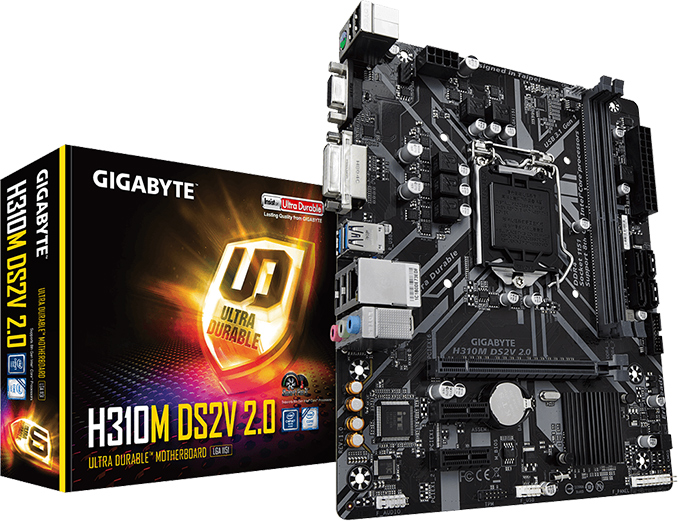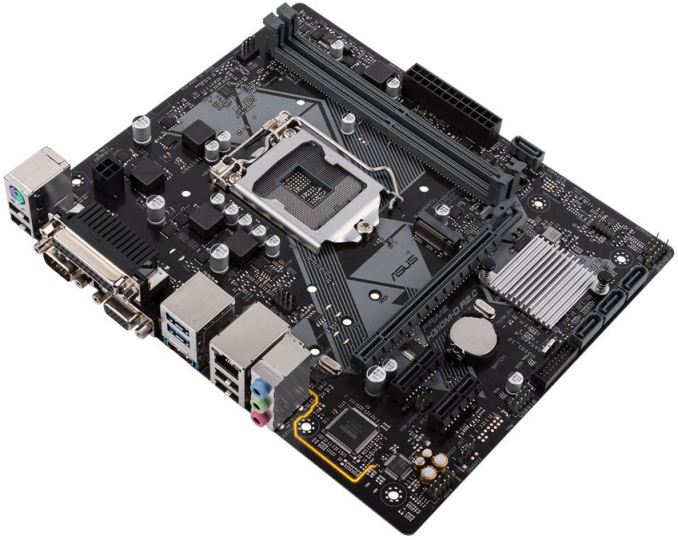Intel Preps New H310 Chipset Revision With Windows 7 Support For Coffee Lake
by Anton Shilov on August 9, 2018 10:00 AM EST
Based on some recent hardware releases from motherboard vendors, it would appear that Intel is prepping a new chipset and appropriate drivers to enable Coffee Lake processors to work with Microsoft’s nine-year-old Windows 7 OS.
Microsoft limited support for the latest CPUs on Windows 7 back in 2016, which is why AMD’s Ryzen as well as Intel’s Kaby Lake, Coffee Lake, and some other chips cannot work with this OS. Meanwhile, Windows 7 defiantly remains a commonly-used operating system both among businesses and individuals who cannot, or do not want to, jump to Windows 10. In a bid to satisfy demand from such users, it would appear that Intel is prepping a special version of its H310 PCH that will enable operation of its latest Coffee Lake processors on Windows 7. ASUS and GIGABYTE already list appropriate motherboards on their websites, but there are a number of catches.
The new chipset is expected to be branded as the H310C or the H310 R2.0, according to a media report and information from makers of mainboards. The PCH allegedly has a new device ID, but is supposedly pin-to-pin compatible with the original H310, though this fact could not be verified at press time. The chipset will ship with Windows 7 x32/x64 drivers for Intel Management Engine Interface, Intel Rapid Storage Technology (SATA), and Intel USB 3.0 drivers. Meanwhile, motherboard makers will have to outfit their products with appropriate Windows 7-compatible drivers for audio and GbE chips they use. Unfortunately, Intel does not seem to plan releasing Windows 7 drivers for its latest iGPUs, so PCs running Intel's Coffee Lake on the H310C (H310 R2.0) and Windows 7 will have to use a discrete graphics card instead. This will naturally make systems running the long-standing OS a bit more expensive than modern PCs with iGPUs.
Intel’s H310 is the company’s entry-level chipset for Coffee Lake processors, so it does not support PCIe 3.0 lanes, USB 3.1 Gen 2, Intel Optane Memory caching SSDs (not that these are supported under Windows 7 anyway), and so on. Evidently, these limitations are important for performance-minded users, so the H310C (H310 R2.0) is not going to appeal to enthusiasts who would like to keep using Windows 7 for some reason. In the meantime, special-purpose systems that need the OS (yet can take advantage of new CPUs) will adopt the platform wholeheartedly despite costs and limitations.
Makers of motherboards already list their ‘Intel H310 R2.0’ badged products on their websites. ASUS has four of them, GIGABYTE also has four SKUs, Colorful is reportedly prepping two models, but does not list them just now. Both ASUS and GIGABYTE offer Windows 7 drivers with their H310 R2.0 (H310C) motherboards, which is a proof of compatibility. Meanwhile, USB 3.0 drivers that the companies ship are intended for Intel’s 200-series chipsets and older.
| Intel H310C (H310 R2.0) Motherboards | ||||
| ASUS | Colorful | GIGABYTE | ||
| Micro-ATX | Prime H310M-D R2.0 Prime H310M-E R2.0 Prime H310M-A R2.0 Prime H310M-K R2.0 |
C.H310M-E V20 C.H310M-E D3 V20 |
H310M DS2V 2.0 H310M S2 2.0 H310M DS2 2.0 H310M H 2.0 |
|
Driver support is of course very important to make Coffee Lake/H310C combination work on Windows 7, but there is another crucial ingredient — the Windows Update service. At present Microsoft does not issue any Windows 7 updates to systems running unsupported processors and will advise their owners to upgrade to Windows 10 instead. Therefore, to make the Coffee Lake/H310C viable for businesses, Intel will need to ensure that Microsoft supports such systems as well. Microsoft for their part has not announced anything on the matter yet, so either Intel is working on a rather one-sided plan here, or the two vendors have a bigger plan in motion to resume OS support for the new H310 revision.
Since two of the world’s largest makers of motherboards already list their Intel H310 R2.0 (H310C) products on their websites, it is likely that the new platforms will hit the market shortly. It is unlikely that companies like ASUS or GIGABYTE will charge a hefty premium for Windows 7 support, after all these are entry-level motherboards. Meanwhile, what remains to be seen is whether and how Microsoft will support such platforms at all.
Related Reading:











25 Comments
View All Comments
PingSpike - Thursday, August 9, 2018 - link
Colorful C.H310M-E D3 V20The model number suggests this may be a DDR3 motherboard.
GreenMeters - Thursday, August 9, 2018 - link
If MS would just release a Win10-compatible version of Media Center, or open source it so someone can continue the work, I'd gladly upgrade.Samus - Thursday, August 9, 2018 - link
That still pisses me off to this day I continue to run Windows 8.1 with the media pack extension just for that reason...spaceship9876 - Friday, August 10, 2018 - link
can you not just use Kodi?ltcommanderdata - Thursday, August 9, 2018 - link
It seems like it's a similar question on the high-end. Motherboards makers provide full Windows 7 drivers for the X299 chipset, but does Microsoft actually allow Windows Update support for Skylake-X CPUs?BobSwi - Thursday, August 9, 2018 - link
What a scam, Windows10 is a hot pile of spyware so much so that Intel and motherboard makers have to spend time and money developing new Windows 7 offerings still, LOL.Microsoft needs to pull their head out of the governments ass, take out the junk in Windows, and release LTSB as their base product.
I mean even the friggin Server OS in 2019 STILL has mobile crap embedded and defaulted to ON, i.e. "Allow access to the camera on this device" & "Allow access to call history on this device", absurd.
romrunning - Thursday, August 9, 2018 - link
Ease up on the FUD.You do not have to install the GUI part ("Desktop Experience") for Windows Server. You can run it as a Core installation only. That's been around for a while now.
PeachNCream - Thursday, August 9, 2018 - link
I'm not quite as upset as Bob about server, but there are some capabilities that are a bit odd to enable by default to a server operating system with the GUI installed. Then again, there have been questionable value-adds for server operating systems out of Microsoft for ages so this isn't anything new. Harden your systems and get on with life.darckhart - Thursday, August 9, 2018 - link
Any word if AMD plans to do same?Samus - Thursday, August 9, 2018 - link
Wait, I thought Ryzen run fine on Windows 7?